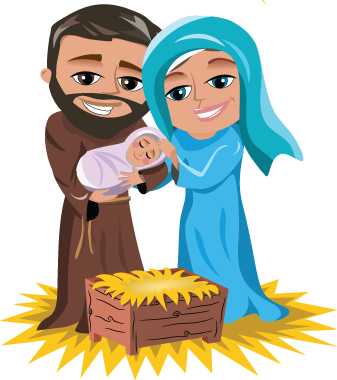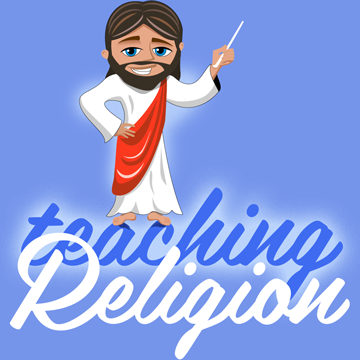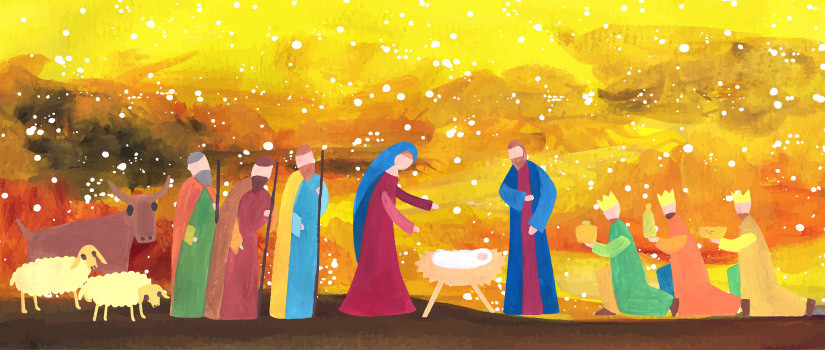This classroom lesson plan is also used as the demonstration lesson in the Teachers Workshop (Part III).
Download Full-Size Image
Part I • Sing-Along: Teaching The Christmas Story Classroom Lesson Plan
Download the lesson plan:
Classroom Lesson Plan (PDF) DownloadLesson Structure & Materials
Teaching The Christmas Story is structured as a sing-along, and includes dramatization. Experienced teachers will enjoy staging the drama. But, some of the less experienced teachers may take a more simple approach. No problem. The sing-along Christmas story lesson can easily be taught with none of the drama. Just ignore the Staging Directions.
- Minimum requirements: Storyteller(s), bibles, copies of lyrics and sheet music* for students, and a song leader, which your church can easily supply.
- If the lesson must be shortened, remove the Composer’s Stories from the script.
There are many versions of each carol. Some include verses that refer to the sufferings and Resurrection of Jesus. Since Holy Week events are not part of the Christmas story, I recommend those verses be avoided. It is best to teach one event at a time.
Choose your actors. Tell them they will remain part of the class until their moment for acting comes. You, the teacher, are the Director and primary Storyteller. The front of your classroom is the stage.
- Seat Mary (holding the infant Jesus) and Joseph center front.
- Seat the Shepherds in a side aisle.
- Seat the Wise Men in the other side aisle.
* Please refer to Part II for details relating to music, staging and props. To avoid copyright issues, I leave supplying sheet music to you or your teaching staff.
1 Introduce the Christmas story classroom lesson.
Christmas is the happiest time of the year. This celebration opens our hearts. We smile a lot. We are more affectionate with our loved ones. We are more generous toward the poor.
Why all this joy?
We are celebrating the moment God entered into human history as a living person on the night of Jesus’ birth.
Today, we will sing the Christmas carols that tell the story of that long ago night. As we sing and perform the Christmas story, the music will open our imaginations. In our minds, we will travel back across the centuries and connect with our spiritual ancestors.
2 Introduce the Sing-Along: Do You Hear What I Hear?
Our first sing-along takes us to the first moments of the Christmas story.
Imagine the setting. It is just over 2000 years ago, in a field outside Bethlehem. A group of shepherds is gathered around a campfire. The sheep are bedded down for the night and everyone is sleeping.
Now imagine you are sitting on a large rock next to a shepherd boy cradling a baby lamb in his arms. You are feeling curious. You are wondering what will happen during this mysterious adventure into such an ancient time. Soon, you hear a faint, strange sound. You listen carefully. Is someone singing?
The beautiful music grows louder. The shepherds awaken. The song seems to be coming from a path of light beaming down from the sky. You strain to see more clearly. Is that an enormous angel approaching you? Behind the angel, in the distance, is that a choir of angels following him? Can you believe what you are seeing? What is the angel saying?
In 1962, Noel Regney and Gloria Shayne were asked to write a Christmas song for a concert group. As Noel considered it, his thoughts turned to the night the Prince of Peace was born, and to the message of the announcing angels:
“Glory to God in the highest and Peace to His People on earth.”
He imagined the shepherds’ response to the angels and wrote a poem describing their sense of wonder. This Christmas story sing-along is cast as a dialog between a shepherd boy and a shepherd man (or lamb). The boy is extremely excited and full of questions.
Gloria Shayne set Noel’s poem to music, and presented the world with a new Christmas carol, Do You Hear What I Hear?
Classroom Instruction:
This carol teaches the Christmas story in both words and feelings. Look at the sheet music and notice all the upward notes. They express the shepherds’ excitement and confusion. During our sing-along, the upward notes will make us feel as the shepherds felt: surprised, confused, and full of wonder.
While we sing along with Do You Hear What I Hear, continue to imagine you are sitting with the shepherds. Look around at the others. Everyone is asking questions. Each person is wondering, “Are the others hearing what I’m hearing? Am I dreaming?”
Activity: Sing along with, Do You Hear What I Hear?
3 Introduce the next Sing-Along: Hark, The Herald Angels Sing.
The music in our Christmas story becomes more excited. Heaven opens and now we see clearly. Yes, it definitely is a vast choir of angels, moving along the starlight path toward us. The angels are bursting with enthusiasm as they announce the birth of the Savior.
“Glory to the newborn king!”
The old, English carol, Hark, the Herald Angels Sing, helps us share the amazement of the shepherds as they tell each other what the angels are saying.
Hark the Herald Angels Sing was written in 1739 by Charles Wesley, brother of the founder of the Methodist Church. 100 years later, Felix Mendelssohn revised the music to emphasize the feeling of the great announcement.
As we continue our sing along of the Christmas story, notice how the sound of the rising notes gets louder and louder. The words are fast, clear, clipped. The music is demanding us to wake up and pay attention!
Classroom Instruction:
Review with your class the unusual words in the second verse, if necessary. Ask students: What are some other words for “hark”? (I like “Listen-up, you mortals!”) What is another word for “herald”?
Activity: Sing along with the first two verses of Hark, The Herald Angels Sing.
4 Introduce the next Sing-Along: Joy To The World.
Isaac Watts, another English preacher who lived in England during the same century as Charles Wesley, was drawn to the meaning of the angels’ message. In his carol, Joy To The World, he gave voice to the intensity of the escalating excitement in heaven. At this point in the Christmas story, after centuries and centuries of waiting, the angels can at last announce the birth of the Savior!
At the time Isaac’s carol was composed, church music had to be soft and monotonous. This was virtually a law. The rebellious, young Isaac Watts found it so boring, he complained to his father. Dad listened, and suggested Isaac write something better.
Thank you, Dad! Among the 600 hymns Isaac Watts composed, we find Joy To The World, one of the most popular Christmas carols of all time.
With great, triumphal sounds, the angels proclaim that JOY has come to the world in person (John 15:11). They use extravagant words to describe him: King, Messiah, Savior, and they proclaim He will rule the world with truth and grace. This gift from God is so wonderful the angels call for all earth to rejoice. An over abundance of high notes carry us into the angels’ exhilaration.
For a few moments, let us sing with the angel choir. Like them, we are calling to earth. Sing loudly! Share their excitement!
Activity: Sing along with Joy To The World.
Classroom Instruction:
The angel’s song was so forceful, the shepherds decide to go to Bethlehem to find the newborn king.
5 Introduce The Joseph And Mary Dialog.
Now the Christmas story moves to the cave in Bethlehem where Jesus was born. The cave is dimly lit with just a few candles. The couple is admiring their newborn baby. What mixed emotions they must feel! It is not difficult to imagine what they said to each other.
Joseph And Mary Dialog
(From their position at stage center, Joseph and Mary stand. Mary holds the infant Jesus, a doll, wrapped in a blanket in her arms.)
Mary
I wrapped him in so many blankets. Can you see him, Joseph?
(Mary tilts the baby up.)
Joseph
He is very handsome.
Mary
I keep wondering about him. Do you think he is an angel?
Joseph
He looks like a little boy to me. Tell me again: What did the angel, Gabriel, say to you?
Mary
I remember the words exactly. But, I still don’t understand them. He said:
You will give birth to a son.
The Lord will make him a king.
And, his kingdom will never end.
Joseph
The angel came to me in a dream. He spoke to me about you. He said: “Mary will have a son, and you will name him Jesus.”
Mary
Imagine! Our son, a king! I think he will be a new kind of king. Maybe he will be–
Joseph
(interrupts) Oh, Mary, be patient. Right now he is just a tiny baby, our baby. I don’t know what plan God has for him, but, whatever it is, it’s a long time from now. For awhile, let’s just enjoy him.
Mary
Look at his eyes. He is watching us. I think he understands everything we say.
(Joseph and Mary sit.)
6 Introduce the next Sing-Along: What Child Is This?
Now, our Christmas story takes us to the home of the composer of What Child Is This? The year is 1865, and we enter a gloomy bedroom in Scotland. We see a very sick young man who has spent months in bed. He is slowly dying. His only comfort comes from the many hours he spends each day reading his bible. Finally, he slips into a coma. Then, something unexpected happens.
He recovers. We don’t have the details, but later, when he was well, William Dix described a near-death experience. He must have met Christ and been given a mission, because he returned to health filled with an abundance of spiritual energy. After this experience the lyrics for some of our most popular hymns just burst out of his imagination.
Dix was so enchanted by the shepherds’ role in the Christmas story that he wrote a poem that described their journey from bewilderment to full insight.
The poem became a Christmas carol when it was set to the haunting, soulful tune of Green Sleeves, a popular English folk song. Today, we know this carol as, What Child Is This?
Classroom Instruction:
Ask students to return to the cave in their imaginations. They see the shepherds arrive, still excited by their experience with the angels. After their miraculous encounter with the angels, they do not know what to expect. Surely, it is something so great it is beyond their imagination. Suddenly, when they see the baby, they stop.
(Shepherds arrive and stop eight feet from Mary and Joseph.)

The shepherds are astonished at the sight of a poorly dressed man sitting in a cow barn next to a poorly dressed young woman holding a sleeping child.
None of them know what to make of the infant. The angels announced the birth of the Messiah. But, this child and his parents are obviously poor “nobodies.” Nevertheless, the shepherds have faith. Something humongous is happening here, but what? Who is this child? They greet the infant Jesus with reverence.
We join the group of shepherds as they begin to sing. With them, we express our feelings of wonder and our care for the child through the long, slow notes of a soothing lullaby.
Activity: Sing along with, What Child Is This?
7 Introduce the final Sing-Along: We Three Kings Of Orient Are.(The Three Kings enter the cave and stop about eight feet from Mary and Joseph. Each King carries his gift.)

In his gospel, St. Matthew describes the visit of three astrologers from the East, probably Persia. They were known as Wise Men, because they were advisors to their king. They correctly interpreted the meaning of the strange behavior of the planets. They had seen a new star, brighter than any ever known. The star had appeared in the constellation Pisces, a group of stars forming the shape of a fish that hovered over Palestine, the House of the Jews. Since they believed the star would lead them to the birthplace of a king from heaven, The Wise Men journeyed to Bethlehem to pay honor to him.
Imagine the surprise felt by the shepherds and Mary and Joseph when these three richly dressed strangers entered the cave. Who were they? Why had such wealthy men come to this lowly place?
A young minister, Henry Hopkins, Jr., captured this moment in the Christmas story when he composed the light-hearted carol, We Three Kings Of Orient Are. It was 1857 in America, a time when our American Christmas traditions were just being born. This jolly carol was Henry’s Epiphany gift for his little nieces and nephews.
In the first verse of We Three Kings, the Wise Men, who are the speakers in this carol, introduce themselves. They have brought gifts to honor the newborn King. This is the reason gift-giving remains an important part of our Christmas tradition today.
No other Christmas carol portrays a more beautiful picture of the Star Of Bethlehem than that sung by the Wise Men in the first Refrain. In the next three verses, each Wise Man names his gift and explains what it symbolizes.
In the last verse, the three join their voices in praise to the Lord, looking forward to His great deeds.
Classroom Instruction:
(One by one, when the appropriate verse is sung, each Wise Man approaches infant Jesus, presents his gift, and steps back.)
It is the bouncy music of this carol that is especially delightful. The music tells us how they feel about the long months of riding on camels to reach this remote country.
As we sing along with the Christmas story, imagine you are riding your camel along with the Wise Men. The bumpy music pulls you into the motions of your camel. You find yourself swaying from side to side. The length of the journey is impressed on you by the length of the words as they are dragged out: “Weeee Three Kiiiiings of Orrrrient Arrrre.”
Activity: Sing along with We Three Kings of Orient Are.
Teacher: lead the swaying motion of the camel.

Now, in the “cave” at the front of our room, we have all the people who gathered around Jesus on the night of his birth.
It is not by accident that they are so different from each other. Under normal circumstances they would never meet. But, on this night, each was a symbol of something larger than himself.
- The Shepherds were men who did not attend the Sabbath worship services. This was because they could not leave their sheep unattended. Nevertheless, their absence was seen as shameful, so they were looked down upon. The shepherds stand for all the outcasts in the world.
- The Three Wise Men are a complicated lot. They are rich. They are Gentiles, and a mixture of races. Their presence tells us that Jesus came to save not just one people, but all the people in the whole world.
- Mary and Joseph represent the faithful Jews and the poor.
Classroom Instruction:
Often, in today’s world, the different kinds of people we see in the manger scene are fighting with each other. So, the message of Jesus’ birth is plain: everyone is invited to come together to worship the Prince of Peace. Those who accept His invitation are taken into Christ’s love, where feelings of hostility fade as JOY flows into their hearts (John 15:11).
Let it be so with us.
Reflection Questions
The mood created while teaching the Christmas story sing-along will leave your class feeling mellow. To preserve this mood, the usual, analytical style of questions should be set aside. A conversational tone is more appropriate. Use the following gentle questions to invite your students to share their experiences and beliefs about Christmas.
- How does your family celebrate Christmas?
- Do any of your decorations illustrate parts of the Christmas story?
- Aside from the exchange of gifts, what do you like best about Christmas?
- Were you surprised that God entered His human life as the son of a couple of modest means?
- What is the basic message of the Christmas story?
(The Christ child invites us to open our hearts to the Divine Love and Joy he brings into the world, and for us to share it with others.)
Concluding Activity
Distribute bibles. It is important that students know that the Christmas story comes from the bible.
Ask students to take turns reading the verses from Luke 2:8-20, and Matthew 1:8 to 2:12 (for easy reading use the Good News Bible).
This concludes the Classroom Lesson Plan (Part I).
View Part II Dramatizing The Christmas Story Sing-Along
View Part III Teachers Workshop: Teaching The Christmas Story

